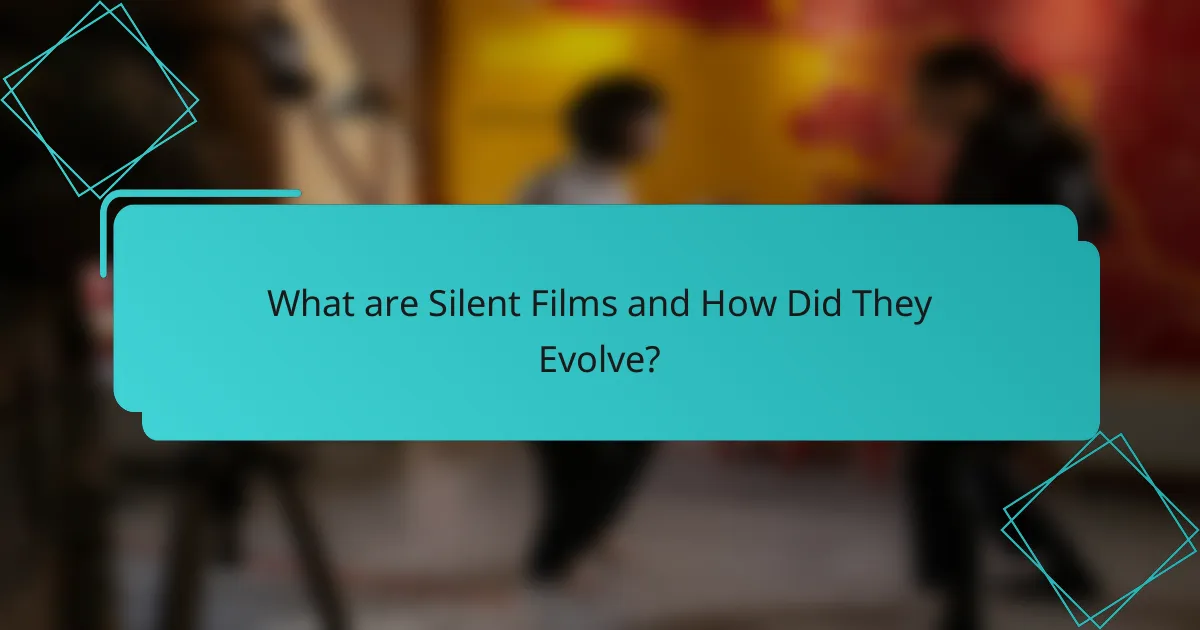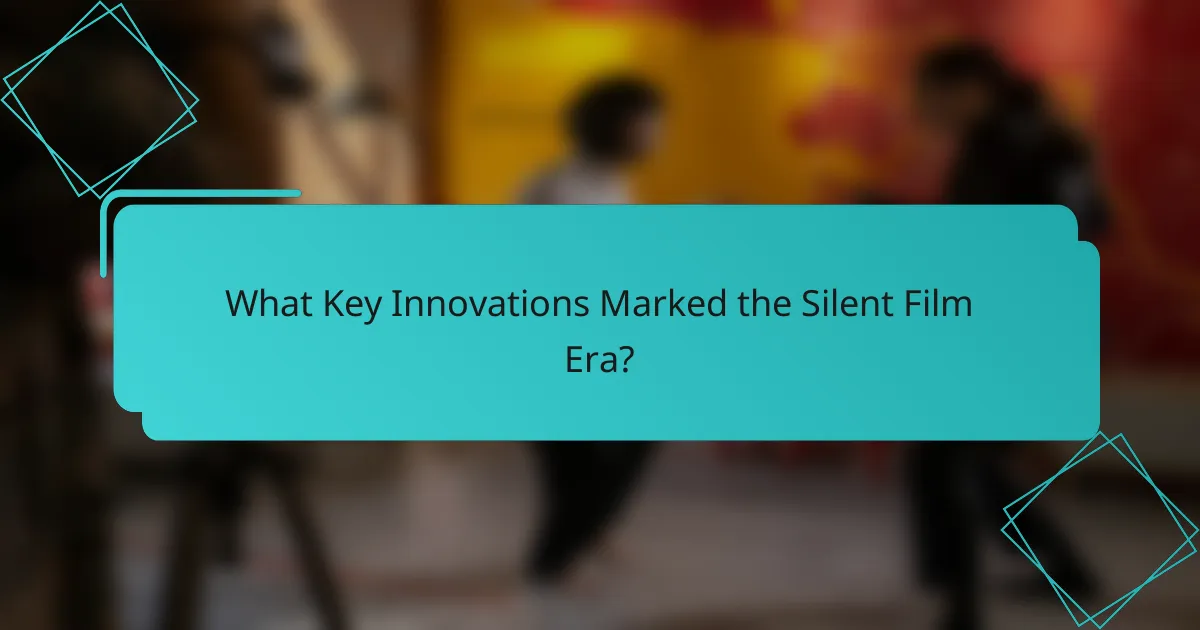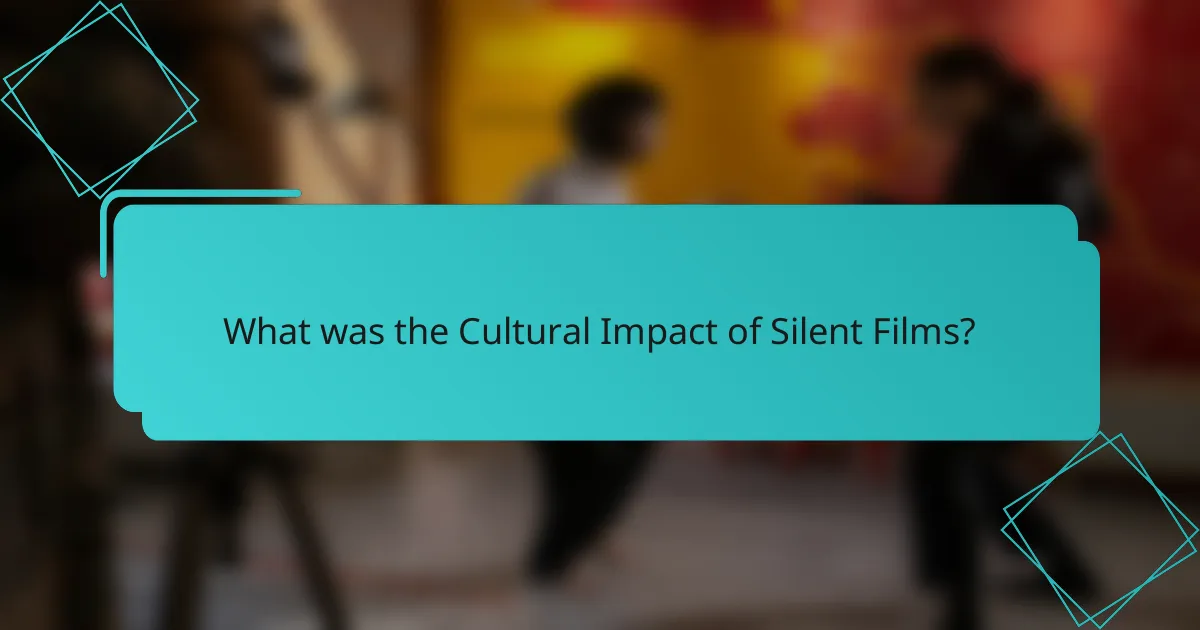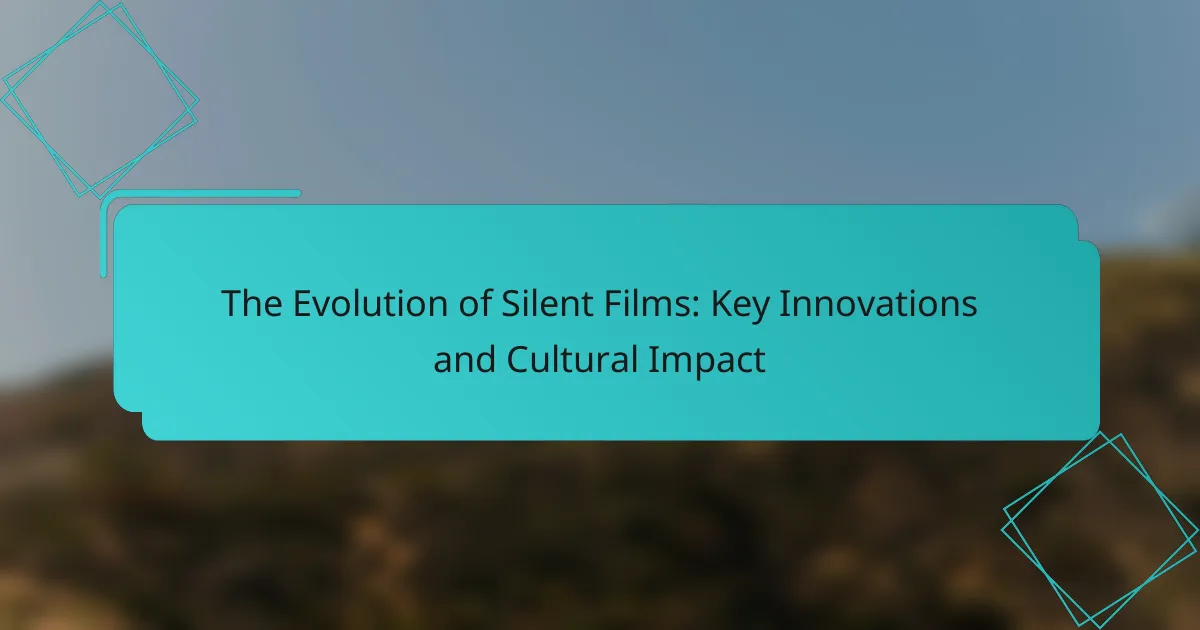Silent films are a significant cinematic format characterized by the absence of synchronized sound for dialogue, relying instead on visual storytelling techniques such as gestures, expressions, and intertitles. This article explores the evolution of silent films, highlighting key innovations like narrative storytelling, camera advancements, and the introduction of live musical accompaniment. It examines the cultural impact of silent films, including their role in shaping early cinema, popularizing genres, and fostering celebrity culture. The transition to sound films in the late 1920s marked a pivotal moment in film history, yet the legacy of silent films continues to influence modern filmmaking and artistic expression.

What are Silent Films and How Did They Evolve?
Silent films are movies that do not have synchronized sound for dialogue. They rely on visual storytelling, using gestures, expressions, and intertitles to convey the narrative. Silent films emerged in the late 19th century, with the first recognized example being “The Horse in Motion” by Eadweard Muybridge in 1878. The format gained popularity in the early 1900s, leading to the establishment of a distinct film industry.
Key innovations included the use of live musical accompaniment and the development of narrative techniques. The introduction of features like longer runtimes and more complex plots marked significant evolution. By the late 1920s, silent films began to decline with the advent of sound films, notably with “The Jazz Singer” in 1927. This transition marked a pivotal moment in cinema history, shifting audience preferences and production methods. Silent films remain a foundational aspect of film history, influencing modern filmmaking techniques.
What are the defining characteristics of silent films?
Silent films are characterized by the absence of synchronized sound and dialogue. They rely on visual storytelling through exaggerated expressions and gestures. Intertitles are used to convey dialogue and narrative information. The music score played during screenings enhances emotional engagement. Cinematography techniques, such as close-ups and long shots, emphasize dramatic moments. The use of physical comedy and slapstick is prevalent to entertain audiences. Silent films often feature elaborate set designs and costumes to create immersive worlds. The era of silent films spanned from the late 19th century to the late 1920s, culminating in the transition to sound films with “The Jazz Singer” in 1927.
How did the absence of synchronized sound shape storytelling in silent films?
The absence of synchronized sound in silent films significantly shaped storytelling by relying on visual elements to convey emotion and narrative. Filmmakers used exaggerated [censured] expressions and physical gestures to communicate character feelings and intentions. Titles and intertitles provided essential dialogue and context, guiding the audience through the plot. The reliance on visual storytelling encouraged innovative cinematography and editing techniques to maintain audience engagement. For example, filmmakers employed close-ups to capture subtle emotions and used creative transitions to enhance narrative flow. The lack of sound also led to the development of live musical accompaniment, which added emotional depth and context to the viewing experience. This combination of visual techniques and live music created a unique storytelling method that defined the silent film era.
What visual techniques were employed to convey emotion and narrative?
Silent films employed techniques such as expressive acting, innovative camera angles, and visual symbolism to convey emotion and narrative. Expressive acting relied on exaggerated [censured] expressions and body language to communicate feelings without dialogue. Innovative camera angles created dynamic perspectives that enhanced storytelling. For example, close-ups highlighted emotional moments, while wide shots established context. Visual symbolism used objects and settings to represent deeper themes. For instance, a broken mirror could symbolize shattered dreams. These techniques collectively enabled silent films to effectively engage audiences emotionally and narratively despite the absence of sound.
What historical context influenced the development of silent films?
The historical context that influenced the development of silent films includes technological advancements and cultural shifts. The late 19th century saw the invention of motion picture technology, such as the Kinetoscope by Thomas Edison in 1891. The Lumière brothers’ first public screening in 1895 marked a significant milestone in film history.
Additionally, the rise of urbanization and industrialization created a demand for new forms of entertainment. Social changes, including the women’s suffrage movement, also influenced film content and themes. The absence of synchronized sound led filmmakers to focus on visual storytelling techniques.
These factors collectively shaped the silent film era, which lasted until the late 1920s when sound films began to emerge. Silent films reflected the societal norms and cultural narratives of their time, making them a vital part of cinematic history.
How did technological advancements contribute to the rise of silent cinema?
Technological advancements significantly contributed to the rise of silent cinema. Innovations in film stock improved image quality and allowed for longer recording times. The introduction of the motion picture camera enabled filmmakers to capture movement more effectively. Electric lighting enhanced visibility, making indoor filming possible. The development of editing techniques allowed for more complex storytelling. These advancements made films more appealing to audiences. By the 1920s, silent films had become a dominant form of entertainment, attracting large audiences worldwide. The combination of these technologies created a unique cinematic experience that defined the era.
What role did cultural factors play in the popularity of silent films?
Cultural factors significantly influenced the popularity of silent films. The rise of silent films coincided with the early 20th century, a period characterized by rapid urbanization and industrialization. This transformation created a shared cultural experience among diverse audiences. Silent films transcended language barriers, making them accessible to global viewers. The visual storytelling relied on expressive acting and intertitles, appealing to a wide range of spectators. Additionally, the cultural fascination with new technologies, such as motion pictures, attracted audiences eager for novel entertainment. The influence of vaudeville and theatrical performances also shaped silent film aesthetics. Overall, cultural factors fostered an environment where silent films thrived and captivated audiences worldwide.

What Key Innovations Marked the Silent Film Era?
Key innovations that marked the Silent Film Era include the introduction of narrative storytelling, the use of intertitles, and advancements in camera technology. Narrative storytelling allowed filmmakers to convey complex plots visually. Intertitles provided essential dialogue and context, enhancing audience understanding. Camera technology improved with the development of the hand-cranked camera, enabling smoother motion. The use of editing techniques, such as cross-cutting, created more dynamic storytelling. Innovations in lighting techniques enhanced visual quality. The introduction of synchronized music scores enriched the viewing experience. These innovations collectively shaped the silent film industry and influenced future cinematic developments.
How did film technology evolve during the silent film period?
Film technology evolved significantly during the silent film period. Innovations included the development of the motion picture camera, which allowed for the capture of moving images. Early filmmakers used hand-cranked cameras, which improved over time with the introduction of electric motors. The introduction of editing techniques enabled filmmakers to piece together scenes more effectively.
The use of intertitles became common to convey dialogue and narrative information. Advances in film stock improved image quality and sensitivity to light. The invention of synchronized sound technology began to emerge towards the end of this period.
These technological advancements laid the groundwork for the transition to sound films in the late 1920s. The silent film era was marked by a rapid evolution in filmmaking techniques and equipment.
What were the significant advancements in camera technology?
Significant advancements in camera technology include the transition from film to digital imaging. This shift allowed for higher resolution and greater flexibility in editing. The introduction of autofocus systems improved focus accuracy and speed. Image stabilization technologies minimized blurriness in moving shots. The development of high dynamic range (HDR) imaging enhanced color and contrast. Additionally, advancements in sensor technology increased sensitivity to light, allowing for better performance in low-light conditions. These innovations collectively transformed the filmmaking process and visual storytelling.
How did editing techniques transform silent films?
Editing techniques transformed silent films by enhancing narrative structure and visual storytelling. Techniques such as cross-cutting allowed simultaneous action to unfold, creating tension and excitement. The introduction of montage created emotional resonance through juxtaposition of images. These methods enabled filmmakers to convey complex ideas without dialogue. For example, D.W. Griffith’s use of editing in “The Birth of a Nation” set new standards for pacing and dramatic effect. Editing also facilitated the transition between scenes, improving the overall flow of the story. As a result, silent films became more engaging and artistically sophisticated. The evolution of these techniques marked a significant shift in cinematic language.
What role did live music and sound effects play in silent films?
Live music and sound effects were essential in silent films. They enhanced the emotional experience of the audience. Musicians would perform live scores that matched the film’s mood. This practice helped convey the narrative and character emotions. Sound effects created a more immersive environment for viewers. The presence of live music was a common feature in theaters during the silent film era. Historical accounts indicate that orchestras often accompanied screenings. This combination of music and sound effects was crucial for storytelling in silent cinema.
How did live performances enhance the viewing experience?
Live performances enhanced the viewing experience by creating an immersive atmosphere. They engaged audiences through live music, sound effects, and actors’ performances. This dynamic interaction captivated viewers more than static visuals alone. The presence of live musicians provided emotional depth to the scenes. For instance, orchestras would synchronize with the film’s action, amplifying dramatic moments. Additionally, live narration helped clarify plot points and guided audience reactions. Historical records show that theaters often employed live performers to enrich the storytelling. This multifaceted approach made silent films more memorable and impactful.
What innovations in sound accompaniment were introduced?
Innovations in sound accompaniment included synchronized soundtracks and sound effects. Synchronized soundtracks allowed music to play in real-time with the film. This created a more immersive experience for audiences. Sound effects added realism to scenes, enhancing emotional engagement. The introduction of the Vitaphone system in 1926 marked a significant advancement. It synchronized sound with film using a phonograph. This technology was first used in “The Jazz Singer,” a landmark film. The success of “The Jazz Singer” demonstrated the potential of sound in cinema. These innovations transformed silent films into “talkies,” changing the film industry forever.

What was the Cultural Impact of Silent Films?
Silent films had a profound cultural impact on society. They shaped early cinema and influenced storytelling techniques. The absence of sound required filmmakers to innovate with visuals and intertitles. This led to a unique form of expression that transcended language barriers. Silent films popularized genres such as comedy and drama, establishing iconic characters like Charlie Chaplin’s Tramp. They also set the stage for the star system, creating celebrity culture. The global reach of silent films fostered cultural exchange, introducing audiences to diverse narratives. Their legacy continues to influence modern filmmaking and artistic expression.
How did silent films influence society and culture?
Silent films significantly influenced society and culture by shaping popular entertainment and social norms. They introduced visual storytelling that transcended language barriers. This accessibility allowed diverse audiences to engage with films regardless of their linguistic background. Silent films also set the stage for the rise of Hollywood as a global entertainment hub in the early 20th century. They impacted fashion and lifestyle trends, as stars like Charlie Chaplin and Buster Keaton became cultural icons. The medium also fostered the development of film techniques and genres that are still prevalent today. For example, the use of exaggerated [censured] expressions and physical comedy laid the groundwork for future comedic styles. Overall, silent films played a crucial role in the evolution of cinema and its integration into everyday life.
What themes and social issues were commonly depicted in silent films?
Silent films commonly depicted themes of love, social class struggles, and the human condition. They often addressed social issues such as poverty, war, and gender roles. For instance, films like “The Kid” by Charlie Chaplin highlighted the struggles of the impoverished. The use of visual storytelling allowed filmmakers to convey complex emotions and societal critiques without dialogue. Historical context shows that silent films emerged during significant social changes, including industrialization and women’s suffrage. This backdrop influenced the narratives and characters portrayed on screen. Silent films served as a reflection of contemporary societal issues and human experiences.
How did silent films shape public perceptions of different cultures?
Silent films significantly shaped public perceptions of different cultures through visual storytelling and representation. The absence of sound required filmmakers to rely on exaggerated expressions and gestures, which often simplified complex cultural narratives. This led to the creation of stereotypes that influenced audience views on various ethnic groups. For example, films like “The Sheik” portrayed Arab culture in a romanticized and exotic manner, impacting Western perceptions. Additionally, silent films often used visual tropes that reinforced existing cultural biases. The global reach of silent films allowed these representations to spread widely, further entrenching misconceptions. Historical context shows that these portrayals contributed to the shaping of cultural identities in the early 20th century.
What legacy did silent films leave for future cinema?
Silent films established foundational storytelling techniques for future cinema. They emphasized visual expression and non-verbal communication. This laid the groundwork for the use of visual cues in film narratives. The incorporation of title cards introduced a new way to convey dialogue and thoughts. Silent films also influenced the development of film editing techniques, such as cross-cutting and montage. These techniques enhanced narrative pacing and emotional impact. Iconic figures like Charlie Chaplin and Buster Keaton set standards for physical comedy and character-driven storytelling. Their work continues to inspire filmmakers today, highlighting the importance of visual storytelling in cinema.
How did silent films pave the way for the advent of sound films?
Silent films laid the groundwork for sound films by establishing narrative techniques and audience engagement methods. These films relied heavily on visual storytelling, which honed the ability to convey emotions without dialogue. Innovations in cinematography and editing during the silent era created a strong visual language. The success of silent films demonstrated the potential for film as a compelling medium. This success encouraged filmmakers to explore audio technology. The introduction of synchronized sound in the late 1920s, exemplified by “The Jazz Singer” in 1927, marked a significant turning point. Audiences were eager for a more immersive experience, which sound films provided. Thus, silent films set the stage for the evolution into sound by proving the viability and popularity of film as an art form.
What lessons can contemporary filmmakers learn from silent cinema?
Contemporary filmmakers can learn the importance of visual storytelling from silent cinema. Silent films relied heavily on imagery and body language to convey emotions and narratives. This approach emphasizes the need for strong visual composition in modern filmmaking. Additionally, filmmakers can draw inspiration from the innovative editing techniques used in silent cinema. Techniques such as cross-cutting and montage were pioneered during this era. These methods can enhance pacing and emotional impact in contemporary films. Furthermore, silent cinema showcased the power of music and sound design in storytelling. The right score can elevate a film’s emotional resonance. Overall, these lessons highlight the value of creativity and innovation in filmmaking.
What are the best practices for appreciating silent films today?
To appreciate silent films today, viewers should engage with the historical context of the era. Understanding the social and cultural background enhances the viewing experience. Additionally, watching films in a theater setting can recreate the original atmosphere. This setting allows for a communal experience, similar to early film screenings.
Using quality restorations of silent films is also important. Restorations often provide better visuals and sound quality. Viewers should pay attention to the visual storytelling techniques used by filmmakers. Silent films rely on expressions and gestures to convey emotions.
Reading intertitles carefully is crucial. Intertitles provide essential context and dialogue. Exploring the work of prominent silent film directors can deepen appreciation. Directors like Charlie Chaplin and Buster Keaton were pioneers in the craft.
Lastly, participating in discussions or watching alongside knowledgeable companions can enrich understanding. Engaging with others allows for shared insights and interpretations. These practices collectively enhance the appreciation of silent films in contemporary contexts.
How can viewers enhance their experience of silent films?
Viewers can enhance their experience of silent films by engaging with the film’s context and using supplementary materials. Understanding the historical background of silent films enriches appreciation. Viewing films with live music creates an immersive atmosphere. Exploring film notes or commentaries provides deeper insights into themes. Attending screenings with discussions fosters community engagement. Reading about the filmmakers and actors adds personal connection. Utilizing subtitles can clarify dialogue and enhance understanding. Engaging with the film’s visual storytelling heightens emotional impact.
What resources are available for exploring silent film history?
Books on silent film history provide comprehensive insights. Notable titles include “Silent Film: A Very Short Introduction” by Charles O’Brien. Online archives like the Library of Congress offer digitized collections of silent films. The British Film Institute also maintains a rich repository of silent cinema. Academic journals such as “Film History” publish research articles on silent films. Documentaries like “The Birth of the Hollywood Sound” explore the transition from silent to sound films. Film festivals often showcase silent films with live music, enhancing the viewing experience. These resources collectively enrich the understanding of silent film history.
The main entity of the article is silent films, which are defined as movies without synchronized sound for dialogue, relying on visual storytelling techniques. The article provides a comprehensive overview of the evolution of silent films, highlighting key innovations such as narrative storytelling, intertitles, and advancements in camera technology. It also examines the cultural impact of silent films on society, their influence on modern filmmaking, and the historical context that shaped their development. Additionally, the article discusses the role of live music, editing techniques, and the legacy of silent films in paving the way for sound cinema.
